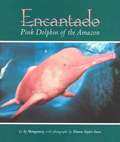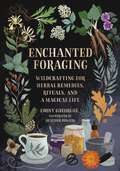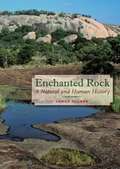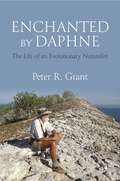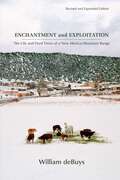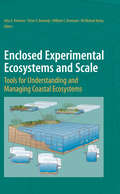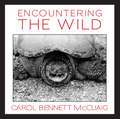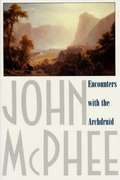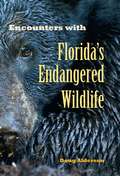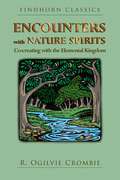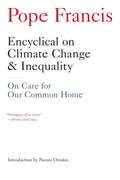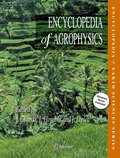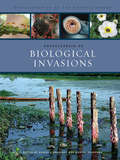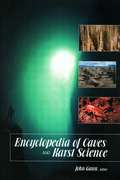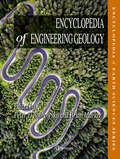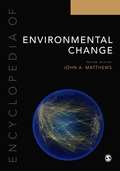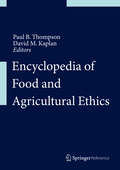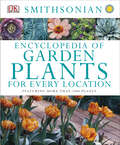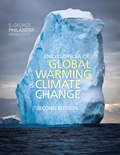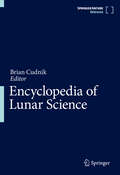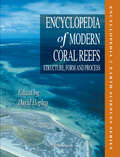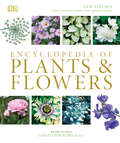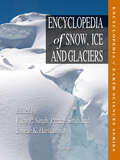- Table View
- List View
Encantado
by Sy Montgomery Dianne Taylor-SnowWelcome to a forest filled with water. In the wet season, the swollen Amazon becomes a looking glass into another world, where pink dolphins swim like something from a dream. In Peru they are called bufeo colorado-the ruddy dolphin. Their color ranges from white to gray to a vivid pink. These astonishing mammals, actually river-dwelling whales, easily navigate their way through the complex, hazardous world of the Amazon rain forest. Encantado invites readers on the adventure of a lifetime as we travel into one of the world's most lush and beautiful jungles in search of these magical creatures. Our guides include scientists and researchers as well as the local people, who have lived with the encantados-the enchanted ones-literally at their doorsteps for centuries. Our main guides are the dolphins themselves. They lead us into myth. They take us back in time to a prehistoric era. They alone can show us the depth of the Amazon's beauty, diversity, and magic-and help us to keep our planet rich and whole.
Enchanted Childhoods: Growing Up in Yosemite, 1864-1945
by Shirley SargentReunion of people from Yosemite Elementary School, the meeting of over fifty alumni and their youthful experiences in Yosemite.
Enchanted Foraging: Wildcrafting for Herbal Remedies, Rituals, and a Magical Life
by Ebony GheorgheEmbark on your foraging journey and cultivate a more meaningful, magical relationship with nature. No matter where you live, natural resources are all around you. These pieces of nature hold inherent properties—and inherent magic—that could be useful to you, and they are often hiding in plain sight. In this book, divided into chapters by season, you'll find: Tips for foraging correctly, mindfully, and sustainably Instructions for teas, balms, decoctions, and other herbal remedies made out of foraged ingredients and materials Wildcrafts for rituals that usher in the new season, inspired by mystical folk practices around the world And more! With practical advice for novice foragers and sidebars on how different cultures have connected with the greatest mystic of all, Mother Earth, Enchanted Foraging explores plants and their various uses not just for consumption but for their intrinsic value. Readers will come away with a more complete knowledge of, and appreciation for, the world that lies just beyond their doors--its abundance, hidden applications, and how it makes enchanted beings of us all.
Enchanted Rock: A Natural and Human History
by Lance AllredWith intriguing domes of pinkish granite surrounded by a sea of Hill Country limestone, Enchanted Rock State Natural Area attracts over 300,000 visitors every year who come to the park to hike, rock climb, spelunk, camp, picnic, and observe birds and wildflowers. Geologists from around the world come to Enchanted Rock to examine landforms that were shaped by forces on ancient continents of Earth more than one billion years ago! All of these visitors, however, are only the latest comers in a line of human history that stretches back 13,000 years to early Native Americans and includes Spanish explorers, Mexican and German settlers, and thirteen private and public owners up to the current owner, the state of Texas. Surprisingly, given the area's wealth of unusual geology, native plants and animals, and human history, no comprehensive guide to Enchanted Rock has been published before now. In Enchanted Rock, you'll find everything you need to fully appreciate this unique place. Lance Allred draws on the work of specialists in many fields to offer a popular account of the park's history, geology, weather, flora, and fauna. Whether you want to know more about how Enchanted Rock was formed, identify a wildflower or butterfly, or learn more about plant communities along the hiking trails, you'll find accurate information here, presented in an inviting style. Over a thousand color photographs illustrate the enjoyable text.
Enchanted by Daphne: The Life of an Evolutionary Naturalist
by Peter R. GrantThe extraordinary life story of the celebrated naturalist who transformed our understanding of evolutionEnchanted by Daphne is legendary ecologist Peter Grant’s personal account of his remarkable life and career. In this revelatory book, Grant takes readers from his childhood in World War II–era Britain to his ongoing research today in the Galápagos archipelago, vividly describing what it's like to do fieldwork in one of the most magnificent yet inhospitable places on Earth. This is also the story of two brilliant and courageous biologists raising a family together while balancing the demands of professional lives that would take them to the far corners of the globe.In 1973, Grant and his wife, Rosemary, embarked on a journey that would fundamentally change how we think about evolution. Over the next four decades, they visited the Galápagos every year to observe Darwin’s famous finches on the remote, uninhabited island of Daphne Major. Documenting how eighteen species have diversified from a single ancestral species, they demonstrated that we could actually see and measure evolution in a natural setting. Grant recounts the blind alleys and breathtaking triumphs of this historic research as he and Rosemary followed in Darwin’s footsteps—and ushered in a new era in ecology.A wonderfully absorbing portrait of a life in science, Enchanted by Daphne is an unforgettable chronicle of the travels and discoveries of one of the world’s most influential naturalists.
Enchantment and Exploitation: The Life and Hard Times of a New Mexico Mountain Range, Revised and Expanded Edition
by William deBuysFirst published in 1985, William deBuys&’s Enchantment and Exploitation has become a New Mexico classic. It offers a complete account of the relationship between society and environment in the Sangre de Cristo Mountains of northern New Mexico, a region unique in its rich combination of ecological and cultural diversity. Now, more than thirty years later, this revised and expanded edition provides a long-awaited assessment of the quality of the journey that New Mexican society has traveled in that time—and continues to travel.In a new final chapter deBuys examines ongoing transformations in the mountains&’ natural systems—including, most notably, developments related to wildfires—with significant implications for both the land and the people who depend on it. As the climate absorbs the effects of an industrial society, deBuys argues, we can no longer expect the environmental future to be a reiteration of the environmental past.
Enclosed Experimental Ecosystems and Scale
by W. Michael Kemp John E. Petersen William C. Dennison Victor S. KennedyEnclosed ecosystem experiments have gained in popularity as research tools in ecological science, particularly in the study of coastal aquatic environments. These systems provide scientists with a degree of experimental control that is not achievable through field experiments. Yet to date, techniques for systematically extrapolating results from small-scale experimental ecosystems to larger, deeper, more open, more biologically diverse, and more heterogeneous ecosystems in nature have not been well developed. Likewise, researchers have lacked methods for comparing and extrapolating information among natural ecosystems that differ in scale. Enclosed Experimental Ecosystems and Scale: Tools for Understanding and Managing Coastal Ecosystems provides scientists, managers, and policy makers with an introduction to what has been termed the "problem of scale", and presents information that will allow for improved design and interpretation of enclosed experimental aquatic ecosystems. The book integrates the results of a 10-year research project involving a multi-disciplinary team of scientists and students to explore scale-related questions in a variety of coastal habitats. Anticipating use as a reference, the book has been designed so that individual sections and individual pages can function as stand alone units.
Encountering the Wild
by Carol Bennett MccuaigPoison Ivy Acres, 250 acres of wilderness in Renfrew County, Ontario, long dedicated to the preservation of natural habitat, has been home to nature writer Carol Bennett McCuaig for many years. Her keen powers of observation, coupled with her insights into wildlife behaviour and her evocative writing style, have produced this captivating collection of stories. Whether noting the courtship rituals of turkey vultures and red foxes or finding a black bear on her roof, an ermine in her bedroom, and a cougar on her lawn, Carol is always surrounded by the delights and challenges of living in a wilderness setting. Even night visitors bring joy, including flying squirrels at the bird feeder, a whippoorwill peering in a window, and a midnight standoff between a porcupine and a skunk. Encountering the Wild is a delightful book that will appeal to country lovers in Canada and beyond.
Encounters With The Archdruid
by John McpheeThe narratives in this book are of journeys made in three wildernesses - on a coastal island, in a Western mountain range, and on the Colorado River in the Grand Canyon. The four men portrayed here have different relationships to their environment, and they encounter each other on mountain trails, in forests and rapids, sometimes with reserve, sometimes with friendliness, sometimes fighting hard across a philosophical divide.
Encounters with Florida's Endangered Wildlife
by Doug AldersonEastern bison roamed Florida into the 1800s. Red wolves disappeared in the 1920s. The dusky seaside sparrow was declared extinct in 1990.It's too soon to say whether the 116 threatened, endangered, or imperiled animal species currently found in the state will also fall victim to climate change, extermination, overdevelopment, or poisons. But as long as they remain, there will be men and women who work tirelessly on their behalf.Combining adventure, natural history, and cultural history, Encounters with Florida’s Endangered Wildlife features chapters tracking panthers, black bears, whooping cranes, manatees, sea turtles, even ivory-billed woodpeckers--which may or may not be extinct. Join Doug Alderson as he travels into prairies, woods, springs, and ocean to come face to face with these and other captivating creatures and learns firsthand about their strangled lives and fragile habitats.With a chapter on the impact of non-native populations of Burmese pythons and Rhesus monkeys, as well as a chilling epilogue that imagines the peninsula one hundred years in the future, this book is a must-read for anyone who wants to know more about the current state of wild Florida.
Encounters with Nature Spirits: Co-creating with the Elemental Kingdom
by R. Ogilvie CrombieA fascinating, first-hand account of the vast powers and true nature of the Elemental Kingdom • Reveals deep wisdom, eloquently shared through the author’s encounters with the great God Pan and his elemental subjects • Offers a glimpse into the hidden layers of the natural world and the workings of the elemental kingdom • Includes chapters by Mike Scott, David Spangler, Dorothy Maclean, and Brian Nobbs as well as beautiful illustrations by fine artist Elise Hurst, who perfectly captures the energy of the natural world and its subjects as we might perceive them “To anyone who may have expressed a wish to see and talk to nature spirits . . . remember it took 63 years for my wish to be granted, so don’t lose hope.” Have you ever wished for something with your whole heart? As a child, R. Ogilvie Crombie (Roc) made a wish as he dropped a penny into a wishing well - he asked to be able to see fairies and talk to them. In Encounters with Nature Spirits, we follow Roc’s path as, many years later, he meets the faun Kurmos in the Royal Botanic Garden in Edinburgh, discovers the realm of the elementals, and, eventually, meets the great god Pan himself. In his conversations with Pan, elves, and other nature spirits Roc realizes that the elemental realm is vastly more powerful than our human kingdom and possesses an ability to create far beyond our human means. Through his experiences Roc becomes closely involved with the Findhorn Community in northeast Scotland where he meets further elementals who give him sound advice as to how the famous Findhorn gardens should be cared for in order to work in harmony with nature. Encounters with Nature Spirits is a reminder to us all of the importance of our relationship with the nature kingdom. Through his example, Roc places emphasis on connecting and working in harmony with nature spirits. True co-creation with nature, working with rather than against the elemental kingdom, can bring about vital positive change to our endangered eco-system. The elementals are open to working with mankind--the question is, are we humans open to engaging with and respecting them again?
Encyclical on Climate Change and Inequality
by Pope Francis Naomi OreskesThe complete text of the landmark encyclical letter from Pope Francis that, as Time magazine reported, "rocked the international community"In the Encyclical on Climate Change and Inequality, the beloved Pope exhorts the world to combat environmental degradation and its impact on the poor. In a stirring, clarion call that is not merely aimed at Catholic readers but rather at a wide, lay audience, the Pope cites the overwhelming scientific evidence of climate change, and does not hesitate to detail how it is the result of a historic level of unequal distribution of wealth.It is, in short, as the New York Times labeled it, "An urgent call to action . . . intended to persuade followers around the world to change their behavior, in hopes of protecting a fragile planet." With an insightful and informative introduction by Harvard professor Naomi Oreskes, famed for her bestselling Merchants of Doubt: How a Handful of Scientists Obscured the Truth on Issues from Tobacco Smoke to Global Warming.From the Trade Paperback edition.
Encyclopedia Brown's Book of the Wacky Outdoors
by Donald J. SobolA collection of humorous anecdotes, most of which are true, about outdoor life, with an emphasis on fishing and hunting.
Encyclopedia of Agrophysics
by Charles W. Finkl Rainer Horn Eugene V. Shein Jan Gliński Jerzy Lipiec Josse De Baerdemaeker Józef Horabik Krystyna Konstankiewicz Stanislaw Grundas Winfried E. Blum Yakov PachepskyThis Encyclopedia of Agrophysics will provide up-to-date information on the physical properties and processes affecting the quality of the environment and plant production. It will be a "first-up" volume which will nicely complement the recently published Encyclopedia of Soil Science, (November 2007) which was published in the same series. In a single authoritative volume a collection of about 250 informative articles and ca 400 glossary terms covering all aspects of agrophysics will be presented. The authors will be renowned specialists in various aspects in agrophysics from a wide variety of countries. Agrophysics is important both for research and practical use not only in agriculture, but also in areas like environmental science, land reclamation, food processing etc. Agrophysics is a relatively new interdisciplinary field closely related to Agrochemistry, Agrobiology, Agroclimatology and Agroecology. Nowadays it has been fully accepted as an agricultural and environmental discipline. As such this Encyclopedia volume will be an indispensable working tool for scientists and practitioners from different disciplines, like agriculture, soil science, geosciences, environmental science, geography, and engineering.
Encyclopedia of Biological Invasions
by Daniel Simberloff Marcel RejmanekThis pioneering encyclopedia illuminates a topic at the forefront of global ecology--biological invasions, or organisms that come to live in the wrong place. Written by leading scientists from around the world, Encyclopedia of Biological Invasions addresses all aspects of this subject at a global level--including invasions by animals, plants, fungi, and bacteria--in succinct, alphabetically arranged articles. Scientifically uncompromising, yet clearly written and free of jargon, the volume encompasses fields of study including biology, demography, geography, ecology, evolution, sociology, and natural history. Featuring many cross-references, suggestions for further reading, illustrations, an appendix of the world's worst 100 invasive species, a glossary, and more, this is an essential reference for anyone who needs up-to-date information on this important topic. Encyclopedia of Biological Invasions features articles on: * Well-known invasive species such the zebra mussel, chestnut blight, cheatgrass, gypsy moth, Nile perch, giant African snail, and Norway rat * Regions with especially large numbers of introduced species including the Great Lakes, Mediterranean Sea, Hawaiian Islands, Australia, and New Zealand. * Conservation, ecological, economic, and human and animal health impacts of invasions around the world * The processes and pathways involved in invasion * Management of introduced species
Encyclopedia of Caves and Karst Science
by John GunnThe Encyclopedia of Caves and Karst Science contains 350 alphabetically arranged entries. The topics include cave and karst geoscience, cave archaeology and human use of caves, art in caves, hydrology and groundwater, cave and karst history, and conservation and management. The Encyclopedia is extensively illustrated with photographs, maps, diagrams, and tables, and has thematic content lists and a comprehensive index to facilitate searching and browsing.
Encyclopedia of Engineering Geology (Encyclopedia Of Earth Sciences Ser.)
by Peter T. Bobrowsky Claudio Margottini Paul Marinos Brian Marker Martin G. Culshaw Jerome De Graff Laurance Donnelly Michael Hendry Jeffrey R. Keaton Victor Osipov Abdul Shakoor Roy ShlemonThis volume addresses the multi-disciplinary topic of engineering geology and the environment, one of the fastest growing, most relevant and applied fields of research and study within the geosciences. It covers the fundamentals of geology and engineering where the two fields overlap and, in addition, highlights specialized topics that address principles, concepts and paradigms of the discipline, including operational terms, materials, tools, techniques and methods as well as processes, procedures and implications.A number of well known and respected international experts contributed to this authoritative volume, thereby ensuring proper geographic representation, professional credibility and reliability. This superb volume provides a dependable and ready source of information on approximately 300 topical entries relevant to all aspects of engineering geology. Extensive illustrations, figures, images, tables and detailed bibliographic citations ensure that the comprehensively defined contributions are broadly and clearly explained.The Encyclopedia of Engineering Geology provides a ready source of reference for several fields of study and practice including civil engineers, geologists, physical geographers, architects, hazards specialists, hydrologists, geotechnicians, geophysicists, geomorphologists, planners, resource explorers, and many others. As a key library reference, this book is an essential technical source for undergraduate and graduate students in their research. Teachers/professors can rely on it as the final authority and the first source of reference on engineering geology related studies as it provides an exceptional resource to train and educate the next generation of practitioners.
Encyclopedia of Environmental Change: Three Volume Set
by John A MatthewsAccessibly written by a team of international authors, the Encyclopedia of Environmental Change provides a gateway to the complex facts, concepts, techniques, methodology and philosophy of environmental change. This three-volume set illustrates and examines topics within this dynamic and rapidly changing interdisciplinary field. The encyclopedia includes all of the following aspects of environmental change: Diverse evidence of environmental change, including climate change and changes on land and in the oceans Underlying natural and anthropogenic causes and mechanisms Wide-ranging local, regional and global impacts from the polar regions to the tropics Responses of geo-ecosystems and human-environmental systems in the face of past, present and future environmental change Approaches, methodologies and techniques used for reconstructing, dating, monitoring, modelling, projecting and predicting change Social, economic and political dimensions of environmental issues, environmental conservation and management and environmental policy Over 4,000 entries explore the following key themes and more: Conservation Demographic change Environmental management Environmental policy Environmental security Food security Glaciation Green Revolution Human impact on environment Industrialization Landuse change Military impacts on environment Mining and mining impacts Nuclear energy Pollution Renewable resources Solar energy Sustainability Tourism Trade Water resources Water security Wildlife conservation The comprehensive coverage of terminology includes layers of entries ranging from one-line definitions to short essays, making this an invaluable companion for any student of physical geography, environmental geography or environmental sciences.
Encyclopedia of Food and Agricultural Ethics
by Paul B. Thompson David M. KaplanThe field of agricultural and food ethics emerged in the 1980 s as scholars began to recognize the need for explicitly normative scholarship on problems and issues associated with the food system. After 25 years of growth, agricultural and food ethics have blossomed in the wake of food safety scandals and renewed interest in alternative ways to organize the agrifood system. There has been a rapid growth in courses taught and in the entry of new researchers into the topics of agricultural and food ethics over the last five years. Scholarship has now reached a point where there is a need for a cross-cutting reference volume that will enable newcomers to the field to gain orientation to the array of topics and problems, existing scholarship on these topics and problems, and key concepts that have been established in agricultural and food ethics. Active scholars in the field would also benefit from literature reviews and survey articles that facilitate a more cumulative trend in research efforts. "
Encyclopedia of Garden Plants for Every Location: Featuring More Than 3,000 Plants
by DKDiscover everything you need to transform your empty plot into a stunning garden oasis with this gardening encyclopedia.This horticultural gem includes more than 2,000 recommendations from gardening experts and features valuable information and advice to expand on your gardening ideas. Planning your garden has never been this easy with this informative planting guide that every gardener needs on their bookshelf. Here&’s what you&’ll find inside: • Includes planting suggestions for over 30 types of sites, from notoriously dry ground by a hedge or fence to cracks in walls or paving • Explains how to assess site and soil, and presents a stunning range of plant partners and planting schemes • Includes a comprehensive range of more than 3,000 plants organized by size and situation • Simple recipes show you how to create beautiful beds, borders and garden designs • A &“Special Effects&” section helps you find plants with fragrant, colorful or architectural properties and offers solutions to common gardening problems and pests, like slugs, rabbits and deer Whether you have a small urban garden or sprawling acres of land, this gardening guide will help you every step of the way to create your garden masterpiece! You&’ll discover a wealth of information on sections like which plants thrive in shady spots or whittle away in bright sunny areas, or &“Special Effects&” themes like Asian or Greek-inspired garden designs.The Encyclopedia of Garden Plants for Every Location is produced in association with the Smithsonian Institution, whose Smithsonian's Gardens creates and manages the Smithsonian's outdoor gardens, interiorscapes, and horticulture-related collections and exhibits.Your dream garden is within reach thanks to this helpful gardening reference book, perfect for gardeners looking to make the most out of their plot.
Encyclopedia of Global Warming and Climate Change, Second Edition
by Dr George PhilanderThe First Edition of the Encyclopedia of Global Warming and Climate Change provided a multi-authored, academic yet non-technical resource for students and teachers to understand the importance of global warming, to appreciate the effects of human activity and greenhouse gases around the world, and to learn the history of climate change and the research enterprise examining it. This edition was well received, with notable reviews. Since its publication, the debate over the advent of global warming at least partially brought on by human enterprise has continued to ebb and flow, depending literally on the weather, politics, and media coverage of climate summits and debates. Advances in research also change the discourse as new data is collected and new scientific projects continue to explore and explain global warming and climate change. Thus, a new, Second Edition updates more than half of the original entries and adds new perspectives and content to keep students and researchers up-to-date in a field that has proven provocatively lively.
Encyclopedia of Lunar Science
by Brian CudnikThe Encyclopedia of Lunar Science includes the latest topical data, definitions, and explanations of the many and varied facets of lunar science. This is a very useful reference work for a broad audience, not limited to the professional lunar scientist: general astronomers, researchers, theoreticians, practitioners, graduate students, undergraduate students, and astrophysicists as well as geologists and engineers. The title includes all current areas of lunar science, with the topical entries being established tertiary literature. The work is technically suitable to most advanced undergraduate and graduate students. The articles include topics of varying technical levels so that the top scientists of the field find this work a benefit as well as the graduate students and the budding lunar scientists. A few examples of topical areas are as follows: Basaltic Volcanism, Lunar Chemistry, Time and Motion Coordinates, Cosmic Weathering through Meteoritic Impact, Environment, Geology, Geologic History, Impacts and Impact Processes, Lunar Surface Processes, Origin and Evolution Theories, Regolith, Stratigraphy, Tectonic Activity, Topography, Weathering through ionizing radiation from the solar wind, solar flares, and cosmic rays.
Encyclopedia of Modern Coral Reefs
by Peter Davies Colin Woodroffe David Hopley Eberhard Gischler Guy Cabioch † I. G. Macintyre Rachel Wood Terry DoneCoral reefs are the largest landforms built by plants and animals. Their study therefore incorporates a wide range of disciplines. This encyclopedia approaches coral reefs from an earth science perspective, concentrating especially on modern reefs. Currently coral reefs are under high stress, most prominently from climate change with changes to water temperature, sea level and ocean acidification particularly damaging. Modern reefs have evolved through the massive environmental changes of the Quaternary with long periods of exposure during glacially lowered sea level periods and short periods of interglacial growth. The entries in this encyclopedia condense the large amount of work carried out since Charles Darwin first attempted to understand reef evolution. Leading authorities from many countries have contributed to the entries covering areas of geology, geography and ecology, providing comprehensive access to the most up-to-date research on the structure, form and processes operating on Quaternary coral reefs.
Encyclopedia of Plants and Flowers
by Christopher BrickellFind new gardening inspiration with this compelling updated encyclopedia for all gardening enthusiasts!Achieve that beautiful garden oasis you&’ve always dreamed of, and find endless inspiration and guidance for your garden to thrive with this gardening guide! This fully comprehensive yet easy-to-use informative planting guide is what every gardener needs on their bookshelf. Here&’s what you&’ll find inside: • A photographic catalog of 4,000 plants and flowers grouped by type, size, then color, allowing readers to browse and find the best plants for their garden • A detailed &“Plant Dictionary&” describes more than 8,000 species and varieties, and their ideal growing conditions • In the Introduction, a &“Plant Selector&” section lists ideal plants for particular growing conditions, like coastal areas, shady spots and different soil types • Fully updated text from garden plant specialists, with more than 1,380 new plants added, including the latest and most popular cultivars Discover perennials, bulbs, shrubs, trees, succulents and ornamental shrubs, all showcased in beautiful, full-color photography to help elevate your garden to the next level. Use the extensive plant dictionary to look up more than 8,000 plant varieties and the best growing conditions.Written by a team of more than 15 top horticultural specialists under the guidance of internationally renowned gardener and botanist Christopher Brickell, this gardening encyclopedia appeals to all levels of gardeners and continually inspires with achievable garden ideas.This informative yet inspirational book about gardening will appeal to beginners or more experienced gardeners interested in the latest cultivars and horticultural advice.
Encyclopedia of Snow, Ice and Glaciers
by Vijay P. Singh Helgi Björnsson Johannes Oerlemans John F. Shroder Martyn Tranter Michael P. Bishop Pratap Singh Umesh K. Haritashya Wilfried HaeberliThe earth's cryosphere, which includes snow, glaciers, ice caps, ice sheets, ice shelves, sea ice, river and lake ice, and permafrost, contains about 75% of the earth's fresh water. It exists at almost all latitudes, from the tropics to the poles, and plays a vital role in controlling the global climate system. It also provides direct visible evidence of the effect of climate change, and, therefore, requires proper understanding of its complex dynamics. This encyclopedia mainly focuses on the various aspects of snow, ice and glaciers, but also covers other cryospheric branches, and provides up-to-date information and basic concepts on relevant topics. It includes alphabetically arranged and professionally written, comprehensive and authoritative academic articles by well-known international experts in individual fields. The encyclopedia contains a broad spectrum of topics, ranging from the atmospheric processes responsible for snow formation; transformation of snow to ice and changes in their properties; classification of ice and glaciers and their worldwide distribution; glaciation and ice ages; glacier dynamics; glacier surface and subsurface characteristics; geomorphic processes and landscape formation; hydrology and sedimentary systems; permafrost degradation; hazards caused by cryospheric changes; and trends of glacier retreat on the global scale along with the impact of climate change. This book can serve as a source of reference at the undergraduate and graduate level and help to better understand snow, ice and glaciers. It will also be an indispensable tool containing specialized literature for geologists, geographers, climatologists, hydrologists, and water resources engineers; as well as for those who are engaged in the practice of agricultural and civil engineering, earth sciences, environmental sciences and engineering, ecosystem management, and other relevant subjects.
